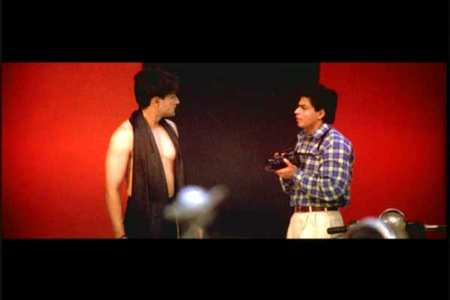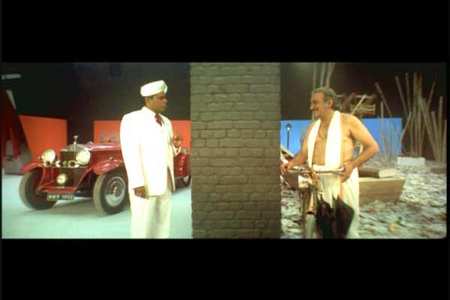Review of Gaja Gamini
Introduction
Yash Raj Home Entertainment who have brought us big titles on to DVD, with decent supplements, now turn their focus on this new and abstract release directed by a noted Indian artist M.F. Husain. The question now on my mind is if Yash Raj and DVD authors Super Digital have captured Husain`s art as best as possible?

Video
This DVD has kept the original intentions of the director as it has been framed according to its original aspect ratio of 2.35:1, a widescreen format. However the DVD is not anamorphic, thus we lose some resolution quality on the picture frame devoting some important lines to the unnecessary black bars. It would have been an improvement to the picture if the authors had devoted some lines to the picture, via an anamorphic transfer.
The DVD has been encoded from a decent 35mm negative source, and as a result only a small fractional sign of white dots can be found in few scenes that won`t distract viewing. Also since this film is a recent release onto DVD other wear and tear blemishes are not visible. Small elements of compression artefacts are also seen during many scenes, and while the picture doesn`t pixilate immensely to reveal them quite literally, they could be seen present to a sharp eyed person. Shimmering and moiré effects didn`t present much of a problem..
Picture information varies from average sharpness to bleak softness. While moments of picture information depicts images clearly, some scenes do have a sense of blur around it. This added jarring to viewing and one would feel that an anamorphic transfer would have resolve this issue for the better. But for a non-anamorphic picture it is what I expected.
Colour definition and saturation was very vibrant with amazing sense of bright colours being shown without distortion. An example can be seen during chapter four when the whole environment is coloured in bright yellow. If the encoding was quite bad then much colour bleeding would be found, but no problems of that variation are detected on this DVD.
Dark and contrast details seemed a little weak as no variation of the different colours of black or white was defined accurately. The blacks founded on this disc seemed too monotone, and contrast levels had an overly sense of brightness affecting the wonderful cinematography ever so slightly.

Audio
The soundtrack has been kept to its original cinema source of Dolby Digital 5.0. It would have been better if the bass was all directed to the LFE channel, thus creating a better handled 5.1 sound for the DVD format. Still while the bass is limited the sound serves to be a good mix, which become quite active during the songs and dances.
However the film itself provides not a lot of sound activity on the surround front as it is not on the scale of an action movie, which tends to have a higher demand on the sound. However when the demand is needed during certain scenes you won`t be disappointed. On a downside note light hissing could be heard during quieter moments on this DVD. It wasn`t as detectable on a normal listening level, but for those who play their DVD`s loud it is a slightly different story.

Features
The animated menus were good and thematic in design, and was easy to navigate over. The English subtitles used to translate the film was very well laided out font and grammar wise. The box design was thematic, and added a sense of value to the overall product.
The DVD also came with two impressive set of supplements. Firstly, the making of documentary which showed the director in his creative mood and explained the viewpoint of the film which the actors had. The only disappointment was that the main actor, Madhuri Dixit, wasn`t interviewed. Her lack of hearsay gives a sense of a black hole while viewing as she could have given an important account of what the film is. Secondly, inside the DVD packaging we get four postcards which are made up of M.F. Husain`s wonderful drawings and film stills.

Conclusion
The film followed an unconventional way of experimenting with cinema. It gave me the impression that it was made up of two concepts. Firstly, the painter/director M.F. Husain aimed to present a tribute to womanhood across the ages. Secondly, it aimed to present his personal love of visions. The film used the celluloid as an experimental tool, with no screenplay, plot or even a structured liner narrative. I personally don`t see this film as a movie, but a moving painting by the artist. He used similar colours, light, shades, and poses seen in his previous works. But this moving painting was very special to the director as the use of stylized sets, nature, actors, words, songs and music helped in his artistic creation to paint on a new surface.
It would be unfair to review Gaja Gamini as I review other films, because this movie is very different. Many won`t understand it, and some will even hate it. While I was confused at some points, I was never bored or restless. I was more mesmerized by the use of the painter`s visual idealizations that was unique to me and to Indian cinema. His drawings on the sets, placement of set props and objects, the set designs themselves were all part of this creative process which helped me to grow into this film more. Also the way the director of photographer Ashok Metha handled the camera helped me more to wonder in agauze with what I was seeing.
The film bared resemblance to the avant garde genre which included wonderful films like `Un Chien Andalou` (1928) and `The Discreet Charm of the Bourgeoisie` (1972), directed by the surrealist Luis Buñuel. These films concentrated on visual imagery instead of a constructive narrative subject matter.
Gaja Gamini has great poetic force, not only with its visuals but with its performances from the whole cast. Top marks for actor Madhuri Dixit who performed the most natural and theatrical expression within this challenging and difficult film. A performance that deserves accolades. Also the dance direction by Saroj Khan, contributed to Husain`s canvas in a positive step.
But it is mostly the dialogues from the film that ended this wonderful dream for me as it tired to simplify the basis of the film. Particular points of this occurred when the poet Kalidas and the scientist, played wonderfully by actors Mohan Agashe and Ashish Vidyarthi, met at the wall and discussed their ideas. Knowing that the film won`t attract much audiences at the box-office, it wasn`t really necessary to induce banal dialogues at this point of the movie. It is this factor and the quite overly background classical music, written by Anuradha Pal that added a sense of distraction when viewing. Its a shame that sound was the weakest creative part of this painting.
I will say that it is a bold film and a great attempt to break away from the conventional film-making narrative that the Indian industry is presently filled with.
The DVD itself is one of Yash Raj & Super Digital better authored titles.
Your Opinions and Comments
Be the first to post a comment!